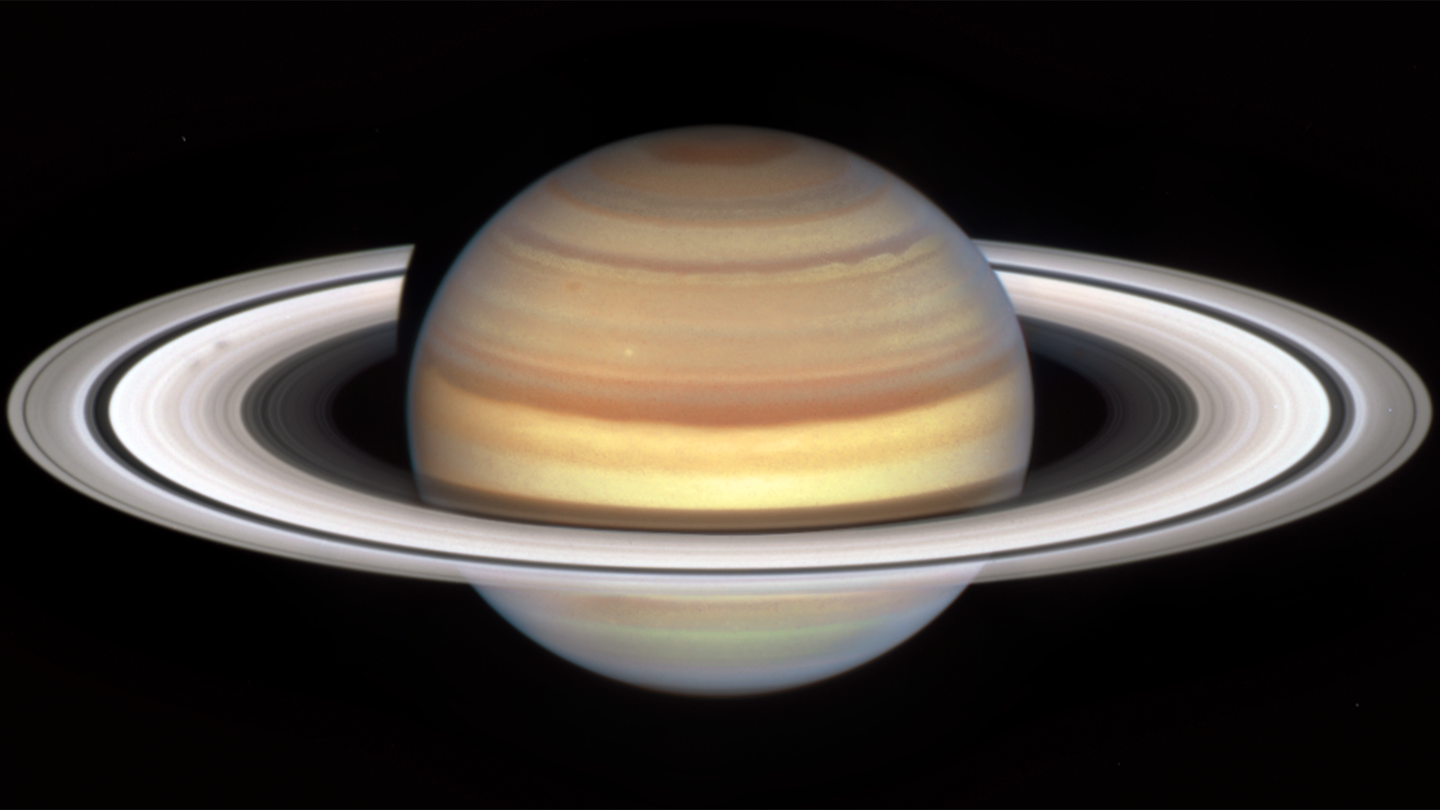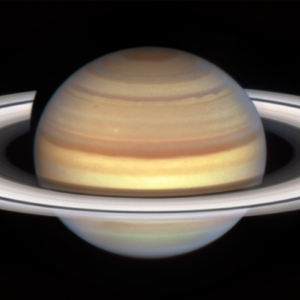One season on Saturn lasts roughly seven Earth years.
 Saturn’s “spoke season,” seen by NASA’s Hubble Space Telescope’s Outer Planet Atmospheres Legacy (OPAL) program. Two smudgy spokes are seen in the B ring (left). The shape and shading of spokes can appear light or dark, depending on the viewing angle, and sometimes appear more like blobs than classic radial spoke shapes, as seen here. NASA, ESA, and Amy Simon (NASA-GSFC); Image Processing: Alyssa Pagan (STScI)
Saturn’s “spoke season,” seen by NASA’s Hubble Space Telescope’s Outer Planet Atmospheres Legacy (OPAL) program. Two smudgy spokes are seen in the B ring (left). The shape and shading of spokes can appear light or dark, depending on the viewing angle, and sometimes appear more like blobs than classic radial spoke shapes, as seen here. NASA, ESA, and Amy Simon (NASA-GSFC); Image Processing: Alyssa Pagan (STScI)
Happy “spoke” season, Saturnians! NASA’s Hubble Space Telescope captured new images of the spoke season during the planet’s equinox, when mysterious smudgy spokes appear around Saturn’s famed rings. Scientists still don’t have a full understanding of what causes these spokes and their seasonal variations.
Saturn is tilted on its axis and has four seasons just like Earth. Since Saturn has a larger orbit around the sun, each season on Saturn lasts about seven Earth years. During this cycle, an equinox occurs when Saturn’s rings are tilted edge-on to the sun, and as Saturn approaches its summer and winter solstices, these spokes disappear.
The autumnal equinox for Saturn’s northern hemisphere is on May 6, 2025 and it gets closer, the spokes are expected to become more prominent and observable.
Astronomers believe that the spokes are caused by Saturn’s variable magnetic field. When a planet’s magnetic field interacts with solar wind, it creates an electrically charged environment.
Scientists believe that the smallest, dust-sized icy ring particles can also become charged, and temporarily levitate those particles above the larger icy particles and boulders in the rings.
NASA’s Voyager mission first observed the ring spokes during the early 1980s. Depending on how much is illuminated and the viewing angle, the strange features can appear dark or light.
To learn more about Saturn and the other gas giants of our solar system (Jupiter, Uranus, and Neptune), Hubble’s Outer Planet Atmospheres Legacy (OPAL) is a project, is taking long time baseline observations of the outer planets to better understand their evolution and atmospheric dynamics. The measurements will be taken throughout the remainder of Hubble’s operation, which could be into the 2030s.
“Thanks to Hubble’s OPAL program, which is building an archive of data on the outer solar system planets, we will have longer dedicated time to study Saturn’s spokes this season than ever before,” said NASA senior planetary scientist Amy Simon, head of the Hubble OPAL program, in a statement.
Saturn’s last equinox occurred in 2009 and NASA’s Cassini spacecraft was orbiting it for close-up reconnaissance. Hubble is now continuing the work of monitoring Saturn and other outer planets for long-term now that Cassini and Voyager have wrapped up their missions.
“Despite years of excellent observations by the Cassini mission, the precise beginning and duration of the spoke season is still unpredictable, rather like predicting the first storm during hurricane season,” said Simon.
While other planets have ring systems, Saturn’s are the most prominent which makes them a good laboratory for studying spokes. “It’s a fascinating magic trick of nature we only see on Saturn – for now at least,” Simon said.
Next, Hubble’s OPAL program will add visual and spectroscopic data to Cassini’s archived observations. Putting these pieces together could paint a more complete picture of the spoke phenomenon and what it can tell us about the physics of planetary rings.
